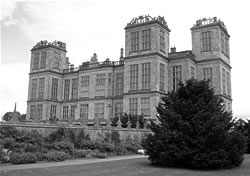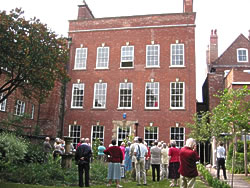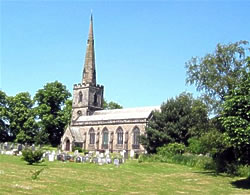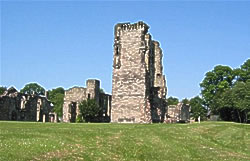Events and excursions, Summer 2006
27 May: Creswell Crags and Hardwick Hall
 |
On a rather overcast and unpromising morning we set off to Creswell Crags, where we were met by the resident archaeologist and his assistant, and divided into three groups. Those of us in the second group had time for coffee and a visit to the museum and to watch a small film, before donning hard hats and walking along the valley to the Church Hole Cave. We climbed the steps to the cave where we listened to a fascinating talk about the people who lived in the valley 13,000 years ago. We had the excitement of seeing the drawings of animals such as deer, birds and bison scratched into the walls and ceiling.
The weather had brightened considerably by this time. Leaving Creswell
for Hardwick Hall [pictured right], (and eating a packed lunch on the way),
we arrived in time to explore the Old Hall, wonder at the intricate plaster
work still remaining, look around the New Hall, and explore the gardens,
including a lovely orchard whose trees were in full blossom. To conclude
our trip we enjoyed a cream tea in the kitchens of the New Hall. This was
a delightful outing, and our thanks go to Leslie Cram for his organization.
Penny Messenger
 |
25 June: Willoughby House, Nottingham
Thoroton members have been exploring some notable City buildings over
past years, and Willoughby House on Middle Pavement was recently the focus
for a visit. Members were met outside the house by Pete Smith, well known
to the Society for his expertise on historic buildings, and the finer details
of the street facing architecture were explained. Within this fine building,
Pete spoke of the history of the house and its associations with Wollaton
Hall, and pointed out the architectural features. Members were intrigued
to see original wallpaper from the house’s earliest periods revealed
behind the upstairs shutters. The garden was also made accessible and,
from there, the most interesting rear elevation could be viewed [pictured
right]. We were very pleased to have Denise Ellis of Franklin Ellis, Architects,
on hand to tell us about the house’s restoration and its conversion
for high-class retail use. She led a group into the caves under the garden,
while other members followed Pete to the upper levels. We are most grateful
to Paul Smith for allowing us to visit the house, now a very fashionable
shop – one or two gentlemen were quite taken with the clothes on
sale! We are especially grateful to Henry who was on hand to welcome us,
and to Christian, the manager, who joined us during the visit. And thanks
also, of course, to Pete and Denise.
Barbara Cast
 |
10 June : Ashby de la Zouche and Ticknall
Fugitives from the World Cup, around three dozen of us set off on one of the hottest days of the year. At Ticknall we were welcomed by Sue Brown and Janet Spavold, pottery enthusiasts, local history researchers and joint authors of the excellent book Ticknall Pots and Potters. Across the churchyard we viewed St George’s church [pictured right], and stood by the remains of St Thomas à Becket, Ticknall, only partly blown up by gunpowder to give space for the building of the present larger church!
Sue and Janet led our group around numerous pottery sites and showed us an impressive display of their finds, including much of the highly decorated ‘cistercian ware’, mis-named through its supposed link with Kirkstall Abbey. Pottery was only one of the links explored: lead and salt mining, coal, water supply, cottage industry, family history, probate inventories, geology and other topics were at their fingertips, not to mention the diplomatic skill needed when negotiating permission to dig!
 |
At Ashby we viewed Saint Helen’s church with its memorials to various
Lords Hastings and that redoubtable widow Selena, Countess of Huntingdon;
the School and Castle [left], its Elizabethan brick tower presaging further
excitement for English Heritage’s excavators; and ‘the seedy
side of Ashby’, narrow alleys off Market Street derived originally
from burgage plots, terraces of housing near the vanished spa building,
and a former Baptist chapel now recycled as a printer’s. We then
had a very welcome and ample high tea at the Methodist Chapel. This was
an outing enjoyable at many different levels, and for many different reasons:
a group of knowledgeable enthusiasts had welcomed us, given us their time,
and imparted at least some of their own inspirations.
Robin Phillips
20 July – Ashover Village and Church, Derbyshire
This excellent visit on a hot and hazy evening started at the Fabrick
Rock viewpoint, where Adrian Henstock pointed out the location and geology
of Ashover, and introduced us to the poetry of local historical character
and ‘jack of all trades’ Leonard Wheatcroft (1627–1706).
Then we drove down to the village hall – a modern impressive complex
that helped Ashover win a national prize for villages with the best community
spirit. We walked through the attractive seventeenth-century stone-built
village and into the churchyard with the ancestral tombs of Florence Nightingale.
We passed the school where recent developments revealed stones marked with
Bronze Age art, to the chapel built by John Smedley (theVictorian textile
king famous for his ‘hydro’) – one of six for his particular
brand of Methodism. Then it was back through the village and past the ‘Red
Lion’ pub – recently re-christened the ‘Old Poet’s
Corner’ – perhaps after our friend Wheatcroft! After a short
walk down a steep path once used as a coffin way leading from remote corners
of Ashover’s vast parish such as Dethick and Lea, we returned to
the church which was opened specially for us, revealing a rare lead font
and a fine Nottingham alabaster monument to the Babington family. A few
well-chosen words from Wheatcroft ended a most enjoyable summer evening.
This event was an experimental one, involving members’ own transport
and without refreshments, but the formula proved popular with attenders.
Janet Roberts